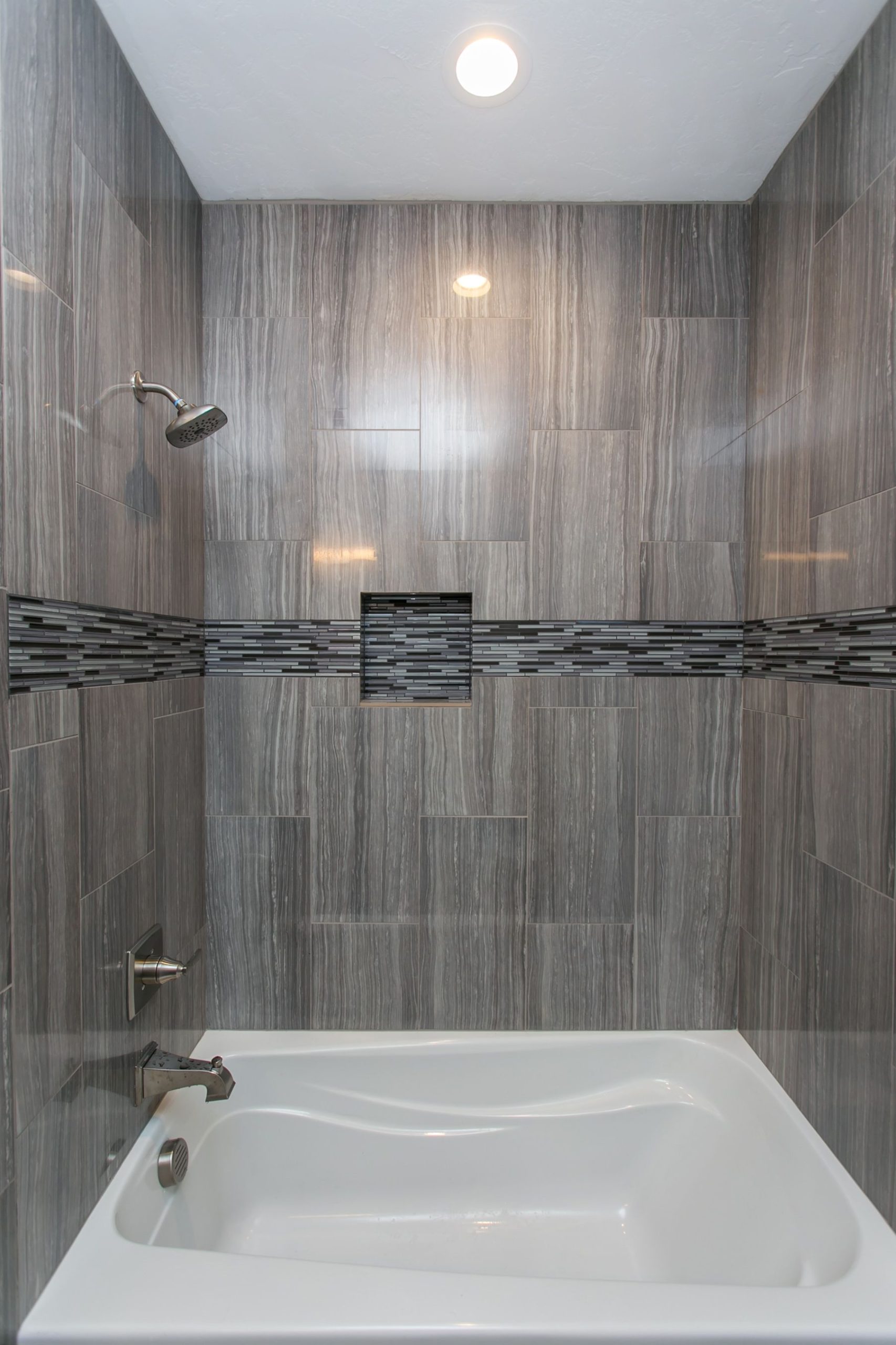Ready to transform your bathroom into a relaxing oasis? A stunning bathtub tile surround can dramatically elevate the style and feel of your space. From sleek and modern to cozy and classic, the right tile choice is key. This guide explores a variety of bathtub tile surround ideas, covering materials, design tips, and practical considerations to help you create the bathroom of your dreams.
Inspiring Tile Surround Ideas
Choosing the right tile for your bathtub surround can completely revamp your bathroom. Let’s explore some ideas to spark your creativity.
Timeless Elegance: Classic Tile Choices
Subway tile remains a perpetually stylish choice, offering design versatility with horizontal, vertical, or patterned layouts like herringbone or chevron. Contrasting grout can dramatically enhance these classic patterns. For a touch of vintage charm, consider incorporating smaller, square tiles in muted tones or a classic black and white checkerboard pattern.
Material Matters: Choosing the Right Tile
Selecting the right tile material is crucial for both aesthetics and practicality.
- Porcelain: Highly durable, water-resistant, and available in a vast range of styles, porcelain can even mimic the look of natural stone or concrete, offering a luxurious look at a potentially lower cost.
- Ceramic: A budget-friendly option with diverse colors and patterns, ceramic tile suits various design styles. However, it may be less durable than porcelain.
- Marble: Exuding timeless elegance, marble adds a touch of luxury with its unique veining. Keep in mind that it requires regular sealing and more meticulous care than other tile types.
- Glass: Reflecting light beautifully, glass tile creates a spa-like ambiance, especially beneficial for smaller bathrooms. Some glass tiles can be slippery, so choose textured options for flooring or wet areas.
- Natural Stone: Materials like travertine, slate, and granite offer unique textures and natural beauty. They typically require sealing and ongoing maintenance to prevent staining and water damage.
Adding Flair: Color, Accents, and Patterns
Inject personality into your bathroom with bold colors and eye-catching accents. A vibrant accent wall featuring your chosen tile can become a striking focal point. Explore deep teal paired with brass fixtures or a warm terracotta against a crisp white backdrop. Mosaic tiles offer intricate patterns, while listello borders add a refined touch, particularly for ceramic tile installations.
Budget-Friendly Beauty: Creative Tile Solutions
Creating a stunning bathroom doesn’t require a fortune. Cost-effective ceramic tiles in creative layouts can make a significant impact. Consider tiling only the areas directly exposed to water and using moisture-resistant paint on the remaining walls to reduce costs without compromising style. Peel-and-stick tile offers a temporary, budget-friendly solution for renters or those who like to change their décor frequently.
Shower-Tub Combo Design: Maximizing Space and Style
Shower-tub combinations present unique design opportunities. A full-wall tile surround creates a seamless, spa-like look. Incorporating a built-in niche or shelf provides practical storage while enhancing the aesthetic. Lighter tile colors can make the space feel larger and brighter. Consider a vertical tile layout to draw the eye upward and create an illusion of height.
Tile Types and Installation: A Quick Overview
| Tile Type | Pros | Cons | Installation Considerations |
|---|---|---|---|
| Ceramic | Affordable, versatile, easy to clean | Can chip or crack, less durable than porcelain | Generally easy to install yourself, but a proper substrate is essential |
| Porcelain | Durable, water-resistant, many style options | Can be more expensive than ceramic and may require specialized cutting tools | Might need special tools for cutting |
| Marble | Luxurious, natural veining, timeless look | Requires sealing, can stain, susceptible to etching | Professional installation is often recommended |
| Glass | Reflective, adds light, spa-like appearance | Can be slippery, more delicate than other tile types | Requires precise installation to ensure even spacing and a smooth finish |
| Natural Stone | Unique textures, natural beauty, durable | Porous, needs regular sealing, potentially expensive | Often requires professional installation. Substrate and sealing are essential |
This table provides a general overview. The optimal tile choice depends on factors like your budget, DIY skills, and desired aesthetic.
Size and Shape: Choosing the Right Tile Dimensions
Large-format tiles create a modern, minimalist feel with fewer grout lines, potentially making a small bathroom feel larger. Smaller tiles, like mosaics, offer intricate detail and are ideal for curved surfaces. Mixing different tile sizes and shapes can create a dynamic and visually interesting bathtub surround.
Finishing Touches: Grout, Fixtures, and Waterproofing
The details matter! Grout color significantly impacts the overall look. Contrasting grout emphasizes tile shape, while matching grout creates a seamless appearance. Choose stylish fixtures and hardware that complement your tile and overall bathroom design. Most importantly, ensure proper waterproofing – it’s essential for a successful and long-lasting tile installation.
What is the best tile for a bathtub surround?
Choosing the best tile for your bathtub surround requires balancing aesthetics, practicality, and budget. Consider your lifestyle and maintenance preferences. Proper installation is crucial for any tile type to ensure longevity and prevent water damage. Let’s delve into the world of bathtub tile surrounds and discover the perfect fit for your bathroom.
Decoding Tile Types: Exploring Your Options
Navigating the numerous tile options can feel overwhelming. Let’s break down the most popular choices:
- Porcelain: Tough, water-resistant, and surprisingly stylish, porcelain offers excellent durability and design versatility.
- Ceramic: A budget-friendly all-rounder with a vast array of colors and patterns, ceramic tile is suitable for various design styles.
- Glass: Adding a touch of glamour and sparkle, glass tiles create a luxurious and reflective surface.
- Natural Stone: From marble to granite, natural stone exudes elegance but typically demands more upkeep and comes with a higher price tag.
Each material possesses unique characteristics. Consider which aligns best with your vision and lifestyle.
Balancing Beauty and Budget: Finding the Sweet Spot
Natural stone, while exquisite, can be expensive and requires ongoing maintenance. Porcelain and ceramic often strike a balance between aesthetics, durability, and affordability. Glass tile prices range from budget-friendly to high-end depending on the design complexity. Assess your budget and maintenance commitment when making your selection.
Installation Insights: The Foundation of a Stunning Surround
Proper installation is paramount for a long-lasting and problem-free bathtub surround. A solid substrate, waterproof membrane, correct grout, and reliable sealant are essential. These elements prevent leaks, mold, and costly repairs. For complex designs or if you lack DIY experience, professional installation is recommended.
Design Deep Dive: Unleashing Your Creativity
Your bathtub surround is a blank canvas. Large-format tiles create a clean, modern aesthetic. Smaller tiles or mosaics offer intricate detailing and flexibility for curves and corners. Mixing shapes and sizes allows for greater creativity. Consider bold colors, unique patterns, or textured tiles to personalize the space. Earthy tones and natural stone evoke a tranquil spa-like ambiance, while geometric patterns and contrasting grout create a modern edge.
Maintenance Matters: The Long-Term View
Consider the long-term maintenance requirements. Natural stone needs regular sealing. Porcelain and ceramic are relatively low-maintenance, easily cleaned with a damp cloth. Glass tiles are also easy to care for. Factor in your lifestyle and cleaning preferences when choosing your tile material.
Beyond Tile: Exploring Alternative Options
While tile reigns supreme, consider alternative materials like acrylic and fiberglass. These offer budget-friendly and straightforward installation but may lack the design flexibility and longevity of tile. Solid surface materials like cultured marble provide a seamless, modern look but can be more costly. Weigh the pros and cons of each material based on your priorities.
Remember, ongoing research suggests new materials and installation techniques may emerge, offering even more options in the future. Stay informed about the latest innovations in bathroom design to make the most informed decision.
What can I use for bathtub surround?
Revamping your bathtub area can transform your bathroom. The bathtub surround makes a significant style statement. Choosing the right material impacts not only the aesthetics but also the maintenance and resale value of your home. Let’s explore various options, from classic choices to innovative alternatives.
Thinking Outside the Tile Box: Alternative Materials
Beyond tile, consider materials like wood for a warm, inviting feel. Wainscoting, shiplap, and beadboard add character and charm. However, when using wood near water, meticulous sealing is essential to prevent moisture damage. Multiple coats of high-quality sealant and regular maintenance are crucial.
Stone and Solid Surfaces: A Touch of Luxury
For a spa-like retreat, explore stone or solid surface materials. Granite exudes luxury and durability. Acrylic or composite surrounds offer a seamless, low-maintenance, and modern alternative. Each material has its own distinct advantages.
Tile: A Timeless Classic with Endless Possibilities
Tile remains a classic choice for its unparalleled versatility. From budget-friendly ceramic to luxurious natural stone, tile caters to diverse styles and budgets. Create intricate patterns with mosaics, embrace the clean lines of subway tile, or make a bold statement with large-format tiles.
Balancing Beauty with Practicalities: Budget, Maintenance, and DIY
Consider practicality alongside aesthetics. Natural stone requires more care than low-maintenance acrylic. Budget plays a crucial role, with ceramic tile being more affordable than marble. Installation complexity varies. Wainscoting, shiplap, and beadboard are relatively DIY-friendly, while intricate tilework or heavy stone slabs often necessitate professional installation.
Your Dream Bathroom Awaits
The ideal bathtub surround depends on your style, budget, and lifestyle. Envision your dream bathroom. Do you prefer clean lines and modern minimalism or warm textures and rustic charm? Let your vision guide you.
Here’s a table summarizing the pros and cons of various materials:
| Material | Pros | Cons | Cost | Installation |
|---|---|---|---|---|
| Wainscoting | Classic style, warm, adds architectural detail | Requires meticulous sealing against moisture | Moderate | DIY-friendly |
| Shiplap | Rustic charm, trendy | Requires meticulous sealing against moisture | Moderate | DIY-friendly |
| Beadboard | Cottage style, cozy feel | Requires meticulous sealing against moisture | Budget-friendly | DIY-friendly |
| Granite | Luxurious, durable | Expensive, heavy, requires professional installation | High | Professional |
| Ceramic Tile | Versatile, budget-friendly, many options | Can chip, grout requires cleaning | Low to Moderate | DIY or Professional |
| Glass Tile | Modern, reflective, adds sparkle | Can be fragile, can be expensive | Moderate to High | Typically Professional |
| Natural Stone | Elegant, unique, natural variations | Requires sealing, porous, can stain | High | Professional |
| Acrylic/Composite | Low-maintenance, easy to clean, durable | Can scratch, may lack design flexibility | Moderate | DIY or Professional |
Discover the warmth and energy efficiency of batt insulation for a cozy and comfortable home. Experience the power and precision of a battery finish nailer for seamless and efficient woodworking projects. Ongoing research in building materials suggests new and exciting options may emerge, so stay tuned for future innovations.
Is it better to tile or use a tub surround?
Choosing between tile and a tub surround requires careful consideration of various factors. Both options have their advantages and disadvantages. This guide helps you make the best decision for your bathroom renovation.
Tub Surrounds: The Speedy and Budget-Friendly Choice
Prefabricated tub surrounds offer quick and affordable installation. Made from materials like acrylic or fiberglass, they are easy to clean and naturally resist mold and mildew. However, design options might be limited compared to the extensive possibilities of tile. While durable, they may not have the same longevity as tile.
Tile: Design Freedom with a Price Tag
Tile opens up a world of design possibilities, from intricate mosaics to luxurious marble. It’s a sought-after feature that can increase home value. However, tile involves a higher cost for both materials and installation, often requiring professional expertise. Maintenance includes regular grout sealing to prevent water damage.
Head-to-Head: Tile vs. Tub Surround
| Feature | Tub Surround | Tile |
|---|---|---|
| Cost | Generally Lower | Generally Higher |
| Installation | Easier, often DIY-friendly | More complex, professional often needed |
| Maintenance | Low, easy to clean | Higher, sealing and cleaning required |
| Design Options | Limited choices | Extensive design possibilities |
| Durability | Good, but can scratch or crack | Excellent with proper installation |
| Resale Value | Can add value | Typically adds significant value |
Making Your Decision: What’s Right for You?
- Tight budget and limited time? A tub surround provides a quick and affordable solution.
- Desire for a custom, high-end look? Tile offers unparalleled design freedom.
- Limited DIY skills? A tub surround is generally easier to install.
- Low maintenance preferences? Surrounds offer hassle-free upkeep.
Consider your lifestyle, including kids or pets, when choosing a durable, easy-to-clean surface. Factor in long-term costs. Tile may have a higher upfront cost, but its longevity can save on replacements later.
Beyond the Usual Suspects: Exploring Alternative Surround Materials
Explore alternative materials like acrylic, composite, and solid surface for tub surrounds. These mimic the look of more expensive options while being easy to maintain. Ultimately, the best choice depends on your individual needs and preferences.
- Greenhouse Storage Shed Combos: Your Guide to Combining Growing and Storage - April 21, 2025
- Greenhouse Shed Combo: Design, Build & Grow Year-Round - April 21, 2025
- Gingham vs. Plaid: What’s the Difference? A Complete Guide - April 21, 2025










